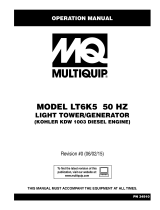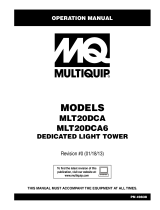
Introduction and Safety
6 Owner’s Manual for MLT Light Tower
Service Safety
This unit uses high voltage circuits capable of causing
serious injury or death. Only a qualified and licensed
electrician should troubleshoot or repair problems
occurring in this equipment.
• Before servicing the unit, verify the Control Power
switch and circuit breakers are in the OFF (O)
position, and the negative (-) terminal on the battery
is disconnected. DO NOT perform even routine
service (oil/filter changes, cleaning, etc.) unless all
electrical components are shut down.
• ALWAYS use extreme caution when servicing this
unit in damp conditions. Do not service the unit if your
skin or clothing is wet. Do not allow water to collect
around the base of the unit.
• DO NOT wash the unit with high pressure hoses,
power washers, or steam cleaners. Water may
collect in the unit, causing damage to electrical parts.
• Replace all missing and hard to read decals. Decals
provide important operating instructions and warn of
dangers and hazards.
• Wear heavy leather gloves when handling winch
cables. Never let cables slip through bare hands.
• Only use mild soap and water to clean the lens covers.
Other chemicals may damage the lens covers.
• Make sure slings, chains, hooks, ramps, jacks and
other types of lifting devices are attached securely
and have enough weight-bearing capacity to lift or
hold the equipment safely. Always remain aware of
the position of other people around you when lifting
the equipment.
Towing Safety
Towing a trailer requires care. Both the trailer and vehicle
must be in good condition and securely fastened to each
other to reduce the possibility of an accident. Some states
require that large trailers be registered and licensed.
Contact your local Department of Transportation office to
check on license requirements for your particular unit.
Hitch and Coupling
•
Verify the hitch and coupling on the towing vehicle
are rated equal to, or greater than, the trailer's
Gross Vehicle Weight Rating (GVWR).
• Verify the trailer hitch and the coupling are
compatible. Make sure the coupling is securely
fastened to the vehicle.
• DO NOT tow trailer using defective parts. Inspect
the hitch and coupling for wear or damage.
• Connect safety chains in a crossing pattern under
the tongue.
• Before towing the trailer, verify that the weight of
the trailer is equal across all tires. On trailers with
adjustable height hitches, adjust the angle of the
trailer tongue to keep the trailer as level as
possible.
• Attach the breakaway cable to the rear bumper of
the towing vehicle.
Running Lights
Verify directional and brake lights on the trailer are
connected and working properly
Wheels and Tires
•
Check trailer tires for wear and proper inflation.
• Verify wheel lug nuts are present and tightened to
the specified torque.
Safe Towing Techniques
•
Practice turning, stopping and backing up in an
area away from heavy traffic prior to transporting
the unit.
• Maximum recommended speed for highway towing
is 45 mph (72 km/h). Recommended off-road
towing speed is 10 mph (16 km/h) or less,
depending on terrain.
• When towing, maintain extra space between
vehicles and avoid soft shoulders, curbs and
sudden lane changes.
Reporting Trailer Safety Defects
If you believe your trailer has a defect which could cause
a crash or could cause injury or death, you should
immediately inform the National Highway Traffic Safety
Administration (NHTSA) in addition to notifying Generac
Mobile Products LLC.
If NHTSA receives similar complaints, it may open an
investigation; and if it finds that a safety defect exists in a
group of vehicles, it may order a recall and remedy
campaign. However, NHTSA cannot become involved in
an individual problem between you, your dealer, or
Generac Mobile Products LLC.
To contact NHTSA, you may either call the Auto Safety
Hotline toll-free at 1-888-327-4236 (TTY:1-800-424-9153),
go to http://www.safercar.gov; or write to:
Administrator
NHTSA
1200 New Jersey Avenue S.E.
Washington, DC 20590
You can also obtain other information about motor vehicle
safety from http://www.safercar.gov.























